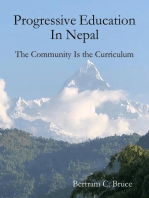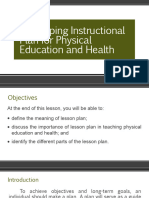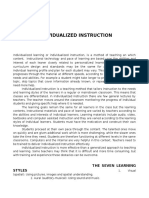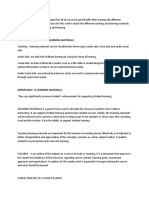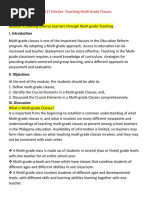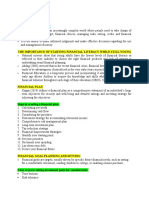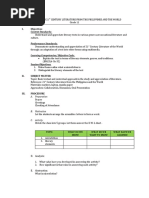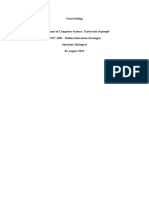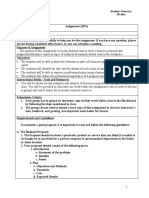What Is Lesson Plan?
What Is Lesson Plan?
Uploaded by
Lyzette Joy CariagaCopyright:
Available Formats
What Is Lesson Plan?
What Is Lesson Plan?
Uploaded by
Lyzette Joy CariagaOriginal Title
Copyright
Available Formats
Share this document
Did you find this document useful?
Is this content inappropriate?
Copyright:
Available Formats
What Is Lesson Plan?
What Is Lesson Plan?
Uploaded by
Lyzette Joy CariagaCopyright:
Available Formats
DIVINE WORD COLLEGE OF LAOAG
LAOAG CITY
SCHOOL OF ARTS, SCIENCES AND EDUCATION
MTB-MLE ASSIGNMENT
1. WHAT IS LESSON PLAN?
It is a teacher's daily guide for what students need to learn, how it will be taught, and
how learning will be measured. Lesson plans help teachers be more effective in the
classroom by providing a detailed outline to follow each class period.
2. WHAT IS THE IMPORTANCE AND USES OF LESSON PLAN?
It emphasizes the need for clarity and comprehension regarding how the entire learning
process will be handled as well as how students can understand and store the
knowledge that is being passed onto them.
It gives teachers the opportunity to think deliberately about their choice of lesson
objectives, the types of activities that will meet these objectives, the sequence of those
activities, the materials needed, how long each activity might take, and how students
should be grouped.
Teachers can reflect on the links between one activity and the next, the relationship
between the current lesson and any past or future lessons, and the correlation between
learning activities and assessment practices.
The lesson will tend to flow more smoothly because all the information has been
gathered and the details have been decided upon beforehand.
The teacher will not waste class time flipping through the textbook, thinking of what to
do next, or running to make photocopies.
3. WHAT ARE THE PARTS OF A LESSON PLAN? DESCRIBE EACH PART.
1. Objectives- the lesson plan objectives are statements that describe the expected
learning outcomes of the learners at the end of the lesson. The objectives specify what
students need to learn and guide learners in carrying out the lesson's activities. Lesson
plan objectives should be aligned with curriculum standards and must be stated in
terms of what learners can/will be able to do at the end of the lesson.
2. Learning resources- this is a list of resources that a teacher uses to deliver the lesson.
These includes the references used and the other resources needed for the different
lesson activities. As stated above, the references a teacher may use include the
teacher's guide and learners' materials.
3. Procedures- the procedure details the steps and activities the teachers and learners
will do during the lesson towards achievement of the lesson's objectives. The
procedure describes the learning experiences that learners will go through in
understanding and mastering the lesson's content. The procedure should clearly show
the different parts of the lesson including before the lesson, during the lesson, and after
the lesson.
Providing assignment or "homework" is a form of post-lesson formative
assessment. The assignment should be related to the day's lesson. The assignment
should allow learners to master what was learned during the lesson or reinforce
what has been taught. Teachers must check assignments promptly.
4. Remarks- teachers shall document specific instances that result in continuation of
lessons to the following day in case of re-teaching, insufficient time, transfer of
lessons to the following day as a result of class suspension, etc.
DIVINE WORD COLLEGE OF LAOAG
LAOAG CITY
SCHOOL OF ARTS, SCIENCES AND EDUCATION
MTB-MLE ASSIGNMENT
5. Reflection- Teachers are encouraged to think about their lessons particularly the parts
that went well and the parts that were weak and write about it briefly.
4. GIVE SOME TIPS OR GUIDE IN WRITING THE OBJECTIVES OF YOUR
LESSON PLAN.
In the context of lesson planning, you can use the smart criteria to determine your lesson
objectives:
Is the objective specific?
Is the objective measurable?
Is the objective attainable by all students?
Is the objective relevant to your class and students?
Is the objective time-based to align with your syllabus?
5. WHAT ARE THE DIFFERENT METHODOLOGIES AND APPROACHES IN
TEACHING?
1. Teacher-centered approach- the teacher is perceived to be the only reliable source of
information in contrast to the learner-centered approach.
2. Learner-centered approach- in which it is premised on the belief that the learner is also
an important resource because he/she too knows something and is therefore capable of
sharing something.
3. Subject matter-centered approach- subject matter gains primacy over that of the learner.
4. Teacher dominated approach- in this approach, only the teacher’s voice is heard. He/she
is the sole dispenser of information.
5. Interactive approach- in this approach, an interactive classroom will have more student
talk and less teacher talk. Students are given the opportunity to interact with teacher and
with other students.
6. Constructivist approach- the students are expected to construct knowledge and meaning
out for what they are taught by connecting them to prior experience.
7. Banking approach- the teacher deposits knowledge into the “empty” minds of students
for students to commit to memory.
8. Integrated approach- it makes the teacher connects what he/she teaches to other lessons
of the same subject (intradisciplinary) or connects his/her lessons with other subjects thus
making his/her approach interdisciplinary and multidisciplinary.
9. Disciplinal approach- it limits the teacher to discussing his/her lessons within the
boundary of his/her subject.
10. Collaborative approach- it will welcome group work, teamwork, partnerships, and group
discussion.
11. Individualistic approach- it wants the individual students to work by themselves.
12. Direct teaching approach- the teacher directly tells or shows or demonstrates what is to
be taught.
13. Indirect, guided approach- the teacher guides the learner to discover things for
himself/herself. The teacher facilitates the learning process by allowing the learner to be
engaged in the learning process with his/her guidance.
DEFINE THE FOLLOWING TERMS:
DIVINE WORD COLLEGE OF LAOAG
LAOAG CITY
SCHOOL OF ARTS, SCIENCES AND EDUCATION
MTB-MLE ASSIGNMENT
1. Teaching methodology is essentially the way in which a teacher chooses to explain or
teach material to students so they can learn the material. A methodology of teaching can
include the use of lecturing, group or small group discussion activities, and engaging
students as teachers for their peers. Students are encouraged to take responsibility for
their education and to be active participants in the learning process.
2. Teaching approach it is a set of principles, beliefs, or ideas about the nature of learning
which is translated into the classroom.
3. Teaching strategy it is a long-term plan of action designed to achieve a particular goal.
4. Teaching technique it is a well-defined procedure used to accomplish a specific activity
or task.
6. MTB ILOCANO LESSON PLAN
TI DETALYADO NGA GAKET ITI MOTHER TONGUE
I. PANGGEP
II. BANAG NGA AMIRISEN
III. PAMUSPUSAN
Aramiden ti mangusuro
Aramiden ti agad-adal
A. SAGANA/PANAGSAGANA
Amirisen dagiti nalpas nga pinagadalan
Pangayangen/payatan
B. PANAGNGIPARANG
C. PAGLILINNAWANAGAN
D. PAKARAMATAN/PANG-USARAN
E. PANAGSAPASAP
F. KINAPATEG
G. DIREKSYON
IV. PANGSUBOK/KARIT
V. ARAMIDEN DIAY BALAY
You might also like
- Myp Unit Plan 2Document6 pagesMyp Unit Plan 2api-52484518567% (3)
- Progressive Education In Nepal: The Community Is the CurriculumFrom EverandProgressive Education In Nepal: The Community Is the CurriculumNo ratings yet
- Handbook of Research on TeachingFrom EverandHandbook of Research on TeachingCourtney BellNo ratings yet
- Chapter 10 - Planning For TeachingDocument10 pagesChapter 10 - Planning For TeachingLovelyn MaristelaNo ratings yet
- Module 6-Instructional PlanningDocument12 pagesModule 6-Instructional PlanningTimothyLim100% (1)
- Module 4 Lesson 1 FLCTDocument14 pagesModule 4 Lesson 1 FLCTSheryll Jean UsoriaNo ratings yet
- Parts of A Lesson PlanDocument4 pagesParts of A Lesson PlanJanine Panti Tabo100% (1)
- Unit 1 Lesson PlanningDocument17 pagesUnit 1 Lesson PlanningMohsin SameerNo ratings yet
- PE Report G-5Document24 pagesPE Report G-5John Ritz Peralta BatillerNo ratings yet
- Unit II Lesson 5 SC-PEHDocument8 pagesUnit II Lesson 5 SC-PEHJewin OmarNo ratings yet
- My Portfolio in Field Study 2 Cycle 1Document26 pagesMy Portfolio in Field Study 2 Cycle 1ELLAJEAN GALLOGONo ratings yet
- Prof Ed 12 JessaDocument3 pagesProf Ed 12 JessaClarizza Mae Abejo100% (1)
- Maam AllenDay MoriDocument21 pagesMaam AllenDay MoriApple mae EjorangoNo ratings yet
- Lecture 6 TMPGDocument4 pagesLecture 6 TMPGAngela BonaobraNo ratings yet
- Group 6 OutlineDocument10 pagesGroup 6 OutlineFides Ann RivasNo ratings yet
- 24fundmental of Pedagogy Cat - Bem1202Document5 pages24fundmental of Pedagogy Cat - Bem1202d cNo ratings yet
- Team TeachingDocument6 pagesTeam TeachingprabhajeswinNo ratings yet
- Lesson Planning in TeachingDocument10 pagesLesson Planning in TeachingTaskeen ZafarNo ratings yet
- Curriculum EssentialsDocument7 pagesCurriculum EssentialsPaulane Rojas NavaltaNo ratings yet
- Lesson Plan Detailed FINAL EDITING (1)Document29 pagesLesson Plan Detailed FINAL EDITING (1)legaspihannamae011No ratings yet
- Lesson 4Document15 pagesLesson 4Ryan JoaquinNo ratings yet
- Activity4 Powerpoint Presentation .....Document21 pagesActivity4 Powerpoint Presentation .....Jane DVNo ratings yet
- Untπma C≥ Fen-Sa‚Dn Fpyp-T°-J≥: D.El.EdDocument33 pagesUntπma C≥ Fen-Sa‚Dn Fpyp-T°-J≥: D.El.EdmujeebNo ratings yet
- Profed05 Chapter 4Document12 pagesProfed05 Chapter 4senyoritaasydney767No ratings yet
- ShekinahDocument21 pagesShekinahJoel VicenteNo ratings yet
- Individualized Learning or Individualized InstructionDocument11 pagesIndividualized Learning or Individualized Instructionashra m yoosuf100% (1)
- Semi Final Special Topic 1Document8 pagesSemi Final Special Topic 1viancakesdumpNo ratings yet
- CurriculaDocument6 pagesCurriculajane barquinNo ratings yet
- Lesson Planningd2-3Document8 pagesLesson Planningd2-3demissedafursaNo ratings yet
- Shek ReportDocument21 pagesShek ReportJoel VicenteNo ratings yet
- Lesson PlanDocument13 pagesLesson PlanSwastika Thapa100% (2)
- Module 4Document39 pagesModule 4rizamae.tagalanNo ratings yet
- 6.2 - Different Formats of Mathematics Lesson PlansDocument10 pages6.2 - Different Formats of Mathematics Lesson PlansDr. Aysha KhalilNo ratings yet
- Problem Centered Design: V. Crafting The CurriculumDocument9 pagesProblem Centered Design: V. Crafting The CurriculumKarole Niña MandapNo ratings yet
- Soriano, Arcel A. Beed 3a. Written Midterm ExamDocument4 pagesSoriano, Arcel A. Beed 3a. Written Midterm ExamArcel SorianoNo ratings yet
- Written Report Module 5Document6 pagesWritten Report Module 521bgu1100msNo ratings yet
- Teacher PDP 2017-2018Document1 pageTeacher PDP 2017-2018Joy BuenoNo ratings yet
- Fs 4 AnswersDocument12 pagesFs 4 AnswersDecson Sto Domingo67% (15)
- Glaica Mañoso Task 3Document4 pagesGlaica Mañoso Task 3Glaica MañosoNo ratings yet
- 8601 Assignmnt 1Document24 pages8601 Assignmnt 1saimasheikh869No ratings yet
- Group 2 Key PointersDocument6 pagesGroup 2 Key PointersDarlene EsmeraldaNo ratings yet
- Chapter 2 Lesson 2Document4 pagesChapter 2 Lesson 2HeheNo ratings yet
- Edu 2 Chapter 7Document37 pagesEdu 2 Chapter 7Shane LouiseNo ratings yet
- FS 1 Learning Episode 9Document11 pagesFS 1 Learning Episode 9wellanegrace.lemosbillante13No ratings yet
- EDT 308 Lecture Note 2023-2024Document16 pagesEDT 308 Lecture Note 2023-2024realbigsam107No ratings yet
- Module 2Document14 pagesModule 2anyamonte31No ratings yet
- Curriculum DesignDocument32 pagesCurriculum DesignLorena Cabradilla0% (1)
- Chapter 2 Effective Procedures in Teaching Science FinalDocument10 pagesChapter 2 Effective Procedures in Teaching Science FinalJasmine Nicole OsallaNo ratings yet
- Episode 3, Abadilla, Harold Elijah, R.Document12 pagesEpisode 3, Abadilla, Harold Elijah, R.bipolar gangNo ratings yet
- 4cabalteja, Sharen Mae D-La Paz National High SchoolDocument7 pages4cabalteja, Sharen Mae D-La Paz National High SchoolFactura NeilNo ratings yet
- Methods and Principles of TeachingDocument6 pagesMethods and Principles of Teachingmarvinmasangcay.pcNo ratings yet
- Online-Curriculum-Chapter 8 & 9Document11 pagesOnline-Curriculum-Chapter 8 & 9Lovelyn MaristelaNo ratings yet
- Field Study 2 Module 2Document18 pagesField Study 2 Module 2Princess Sabrina Pasillao BandarlipeNo ratings yet
- Elecen 1 Chapter 2Document19 pagesElecen 1 Chapter 2Angela AlquezaNo ratings yet
- PDP Goal 2Document5 pagesPDP Goal 2api-317085485No ratings yet
- ApproachesDocument8 pagesApproaches21-2338-eNo ratings yet
- KhattyM3 EED117Document10 pagesKhattyM3 EED117Khatty SiasicoNo ratings yet
- EPISODE 6 - Creating An Appropriate Learning Environment FS1Document7 pagesEPISODE 6 - Creating An Appropriate Learning Environment FS1Jaja Coleen100% (1)
- Zamboangacity State Polytechnic College Graduate SchoolDocument25 pagesZamboangacity State Polytechnic College Graduate SchoolRosario Perez OcamiaNo ratings yet
- Facilitating Learner-Centered TeachiingDocument3 pagesFacilitating Learner-Centered TeachiingAnne RaycoNo ratings yet
- Philippines' Geographical FeatureDocument8 pagesPhilippines' Geographical FeatureLyzette Joy CariagaNo ratings yet
- Making The Most of Community Resources and Field TripsDocument4 pagesMaking The Most of Community Resources and Field TripsLyzette Joy CariagaNo ratings yet
- Financial LiteracyDocument8 pagesFinancial LiteracyLyzette Joy CariagaNo ratings yet
- What Is My Telos in Life?Document1 pageWhat Is My Telos in Life?Lyzette Joy CariagaNo ratings yet
- Nurturing Creativity Through The Creative ArtsDocument10 pagesNurturing Creativity Through The Creative ArtsLyzette Joy CariagaNo ratings yet
- Teaching Research For STEM TeachersDocument105 pagesTeaching Research For STEM TeachersDon King EvangelistaNo ratings yet
- You AreDocument8 pagesYou Areapi-534309724No ratings yet
- An Ideal TeacherDocument19 pagesAn Ideal TeacherNorimah HussinNo ratings yet
- General ReflectionDocument2 pagesGeneral Reflectionconie marianoNo ratings yet
- Taya Institute College - CLZ: 1. Full-TimeDocument4 pagesTaya Institute College - CLZ: 1. Full-TimeCollins Jr Kashala100% (1)
- GMT Week 10 GMT Socratic EtcDocument23 pagesGMT Week 10 GMT Socratic EtcNoorehiraNo ratings yet
- Research Proposal Trixie O. PapuranDocument49 pagesResearch Proposal Trixie O. Papurandanzkietanaleon10No ratings yet
- Seven Pillars of Creativity in The Primary Classroom PDFDocument8 pagesSeven Pillars of Creativity in The Primary Classroom PDFAnda RascanuNo ratings yet
- Simplified Test Wording Rephrased Test Questions And/or Directions OR Reworded Questions in Simpler LanguageDocument1 pageSimplified Test Wording Rephrased Test Questions And/or Directions OR Reworded Questions in Simpler LanguageSandy WrightNo ratings yet
- Resume: G. Uma Sankar, 25, Sri Sayaram Nagar, (New Saram) Chenniyam Pet, Puducherry-13Document2 pagesResume: G. Uma Sankar, 25, Sri Sayaram Nagar, (New Saram) Chenniyam Pet, Puducherry-13Adhi JayaramNo ratings yet
- CAT 2001 Solved PaperDocument47 pagesCAT 2001 Solved PaperMeethiPotterNo ratings yet
- Functional English For Vocabulary DevelopmentDocument8 pagesFunctional English For Vocabulary Developmentmeyramkyzy0303No ratings yet
- Quiz Module 5&6Document2 pagesQuiz Module 5&6Arolf John Michael LimboNo ratings yet
- ED526 - Module 2 - Assignment 2 - GroupDocument11 pagesED526 - Module 2 - Assignment 2 - Groupterry berryNo ratings yet
- Walsh MS AiDocument19 pagesWalsh MS Aimayank.jain1No ratings yet
- Lesson Plan in 21st Century - COT 4Document2 pagesLesson Plan in 21st Century - COT 4Sofia Tulabing100% (9)
- Term 2 Basic 1 Week 7Document18 pagesTerm 2 Basic 1 Week 7Gyasi EdwinNo ratings yet
- w7 Learning Journal Unit 7Document3 pagesw7 Learning Journal Unit 7afsanasoftNo ratings yet
- Business Proposal MatrixDocument2 pagesBusiness Proposal MatrixAlexNo ratings yet
- Recommendation Letter From TeacherDocument4 pagesRecommendation Letter From TeachernatashkanNo ratings yet
- What Field Did You Say You Were In?: SECTION I Defining The FieldDocument7 pagesWhat Field Did You Say You Were In?: SECTION I Defining The FieldJORGE LUIS MEJIA QUIÑONEZNo ratings yet
- HDF 492 PresentationDocument10 pagesHDF 492 Presentationapi-509108753No ratings yet
- Lesson Plan 4Document3 pagesLesson Plan 4api-283392025No ratings yet
- Project COsDocument3 pagesProject COsprofthirukrishnaNo ratings yet
- Maths Assignment - 230119 - 182824Document3 pagesMaths Assignment - 230119 - 182824Nur Alimi ZukriNo ratings yet
- Assignment 1Document43 pagesAssignment 1api-408480165No ratings yet
- Jamie Slater: EducationDocument2 pagesJamie Slater: Educationapi-534982009No ratings yet
- Special EducationDocument2 pagesSpecial Educationjeanly famat patatagNo ratings yet
- Let's Check Activity 1Document4 pagesLet's Check Activity 1Harry PotterNo ratings yet

